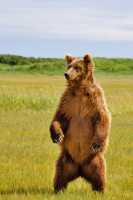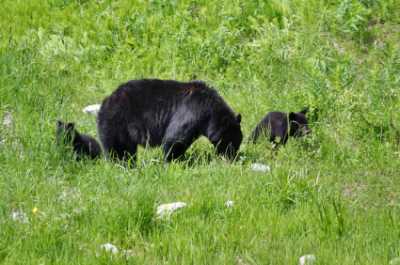|
By Jerry Tardif

|
There are many critters you might meet on a trail ride, but the bigger ones will likely capture your full attention and may possibly bring you close to a panic.
We're hearing more frequent reports of these animals becoming more prevalent and a few have the potential for being very dangerous, such as moose, mountain lions, and bears.
Bear attacks do happen, but fortunately, they're actually very rare.
If you try to get statistics online, you'll often find some sites claiming bear attacks are rare while others claim they're frequent.
So, you have to focus on getting such important information from more authenticated sources.
|
Approximately 28 bear attacks have occurred in the entire U.S and Canada between January 2000 and mid-2010 — that's very, very rare compared with vehicle accidents or homicides (that averages to fewer than 2.7 attacks per year).
Still, none of us wants to meet up with an aggressive bear on the trail (or even a nonaggressive bear).
If you should ever see a bear anywhere that's not in captivity, your behavior can make all the difference between just an observation and a tragedy.
Seeing a Bear
So, let's say you're out riding with a friend and you see a bear — what do you do?
In all cases, STAY CALM — DO NOT approach the bear.
Also, DO NOT run or gallop away.
If on foot, keep this thought in mind: you cannot outrun a bear, so don't try; you'll only make things worse.
Running can elicit what's called "the chase response" in the bear.
Generally, bears prefer to avoid humans and the statistics bear that out (no pun intended).
Some of the few reasons a bear might approach you or feel provoked are:
- Being surprised
- Protecting its cubs
- A rabid bear
- Prior experience getting fed by humans (PLEASE don't feed the bears!)
If you see a bear that doesn't see you, back away quietly and avoid him by taking another path away from him.
If the bear does see you and begins to approach, DON'T RUN!
Talk in a calm and soothing voice.
You can also raise your arms to look bigger.
You want to continue to face the bear, but avoid direct eye contact and slowly back away while talking softly, but loudly enough so he can hear you.
The point is to not show fear, but also to not make the bear feel threatened.
What if the Bear Stands?
If the bear stands on his hind legs, he's not attacking, he's trying to get a better smell of you and/or a better look at you — don't panic.
Even if he approaches slowly, he's just being curious.
Keep talking in a non-emotional tone (that might not seem easy with a high dose of adrenaline coursing through your veins, but it's so very important.)
Slowly back away.
What if you're on a Horse?
If you're on a horse, the horse may badly want to run away.
While your chances of getting away on a horse are better than when on foot, it makes no sense to risk promoting the chase response in the bear.
Your horse could stumble and fall to the ground and both of you could get hurt from the fall, the bear, or even worse: both.
Avoiding Bears
If bears have been seen in the areas where you ride, DON'T RIDE AT NIGHT.
Be alert when you do ride.
Make noise so a bear can hear you coming.
That can mean riding with bells, keeping a conversation going if you're in a group, etc.
That way, he won't be surprised and will likely avoid you.
Stick to the wider trails.
In national and state parks and forests, you can stick to the roads which let you see farther away and also allow for you to be more easily seen from a distance.
If you're carrying food with your for a picnic lunch or some such, make sure it's double-sealed in plastic bags.
If an animal can't smell it, they're less likely to be attracted to you for it.

|
|
A mother and her cubs may look cute, but stay far away for your safety.
|
The chances are that you'll never meet a bear while out on the trail.
Even if you do, your chances of being attacked by a bear is 1/100,000 the chance of being murdered by another human.
While that may seem like a sad commentary on civilization, it at least means you're generally very safe on the trail, even when sharing it with wild animals.
We do need to be careful in life, but we don't want to let fear keep us from riding.
You can learn more from this USDA article entitled: How to Live With Bears.
Besides being an avid trail rider, Jerry Tardif is a technology consultant and a horse and nature photographer in SE Connecticut — see his work at: www.jerrytardif.com.
He is also co-founder and President of QueryHorse.
Back to Article Index
|